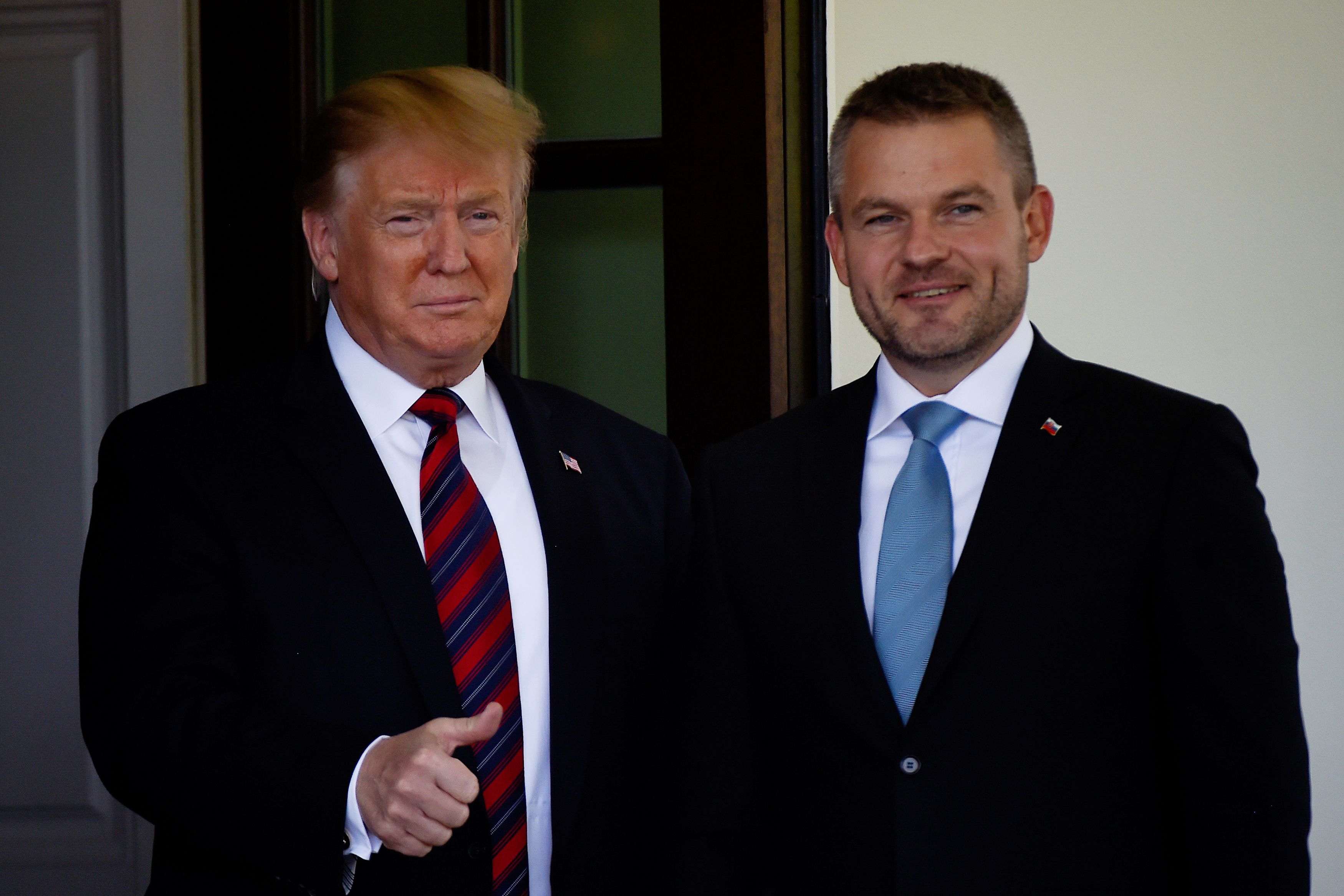Slovakia’s Relations with the United States

Slovak Attitudes Towards the U.S.
The 100th anniversary of the establishment of diplomatic relations between the U.S. and Slovakia (then Czechoslovakia) coincides with the intensification of relations between these countries. The meeting between Pellegrini and Donald Trump in the White House in May (the first since 2015) and the joint statement that followed was preceded by the first bilateral visit in 20 years of a U.S. Secretary of State (Mike Pompeo) to Slovakia in February. Both events are part of this year’s series of meetings between the American administration and the leaders of Visegrad Group (V4) countries, including meetings between Trump and Czech Prime Minister Andrej Babiš and Trump and Hungarian PM Viktor Orbán.
In Slovakia’s government coalition, which includes the Social Democratic Smer-SD, the Slovak National Party (SNS), and the Hungarian minority grouping Most-Híd, the vision of relations with the U.S. remains contentious. While Smer-SD favours strengthening security cooperation, SNS is clearly sceptical of deepening relations with the U.S. The friction in the coalition is evidenced by the corrections released by the Slovak Ministry of Foreign and European Affairs regarding statements by the Speaker of the National Council and SNS leader Andrej Danko, who is critical of cooperation with the U.S. Regardless of party affiliation or political environment, the Slovak authorities do not question the need to continue cooperation with the U.S. This was demonstrated on 27 June by President Zuzana Čaputová, Speaker Danko, and Prime Minister Pellegrini’s renewal of a declaration from 23 October 2017 on the “proEuropean and pro-Atlantic direction in the strategic interests of Slovakia”. The declaration’s content, among other actions, underlines the importance of NATO’s and Slovakia’s efforts to increase defence spending.
The Slovak public is the most sceptical of strengthening relations with the U.S. among the V4 countries. This is due in part to a difference in threat perception, mainly that Russia’s actions do not pose a threat to Slovakia. According to a 2017 International Republican Institute survey, only 36% of Slovaks see the U.S. as a natural partner in building European security (for comparison: 51% of Czechs, 42% of Hungarians, and 60% of Poles view the U.S. in that way). These results correspond to Eurostat research from the same year, according to which 44% of Slovaks view the U.S. positively (compared to 55% of Czechs, 63% of Hungarians and 79% of Poles).
Defence as a Pillar in Relations
For Slovakia, the U.S. is a significant partner in military security. In the U.S., in turn, Slovakia is seen as a reliable partner on NATO’s Eastern Flank. This is due primarily to the modernisation of the Slovak military with the participation of American companies. The purchase of 14 F-16 multirole fighter aircraft (manufactured by U.S.-based firm Lockheed Martin), worth $1.8 billion in total, came in December 2018, and the first four aircraft are to be delivered in 2022. It was the largest purchase in the history of the Slovak military. It complements an order of nine UH-60M Black Hawk helicopters for $261 million. The first six helicopters were delivered by August this year. Both modernisation programmes are designed to replace outdated equipment with American units. The F-16s will replace ageing MiG-29 fighters and the Black Hawk helicopters will substitute legacy Mi 17s.
Slovakia aims to spend 2% of its GDP on defence. At the beginning of 2018, the Slovak government declared it will achieve this goal by 2024 (up from 1.73% of GDP this year). But during the visit to the White House, Pellegrini showcased a more ambitious perspective targeting 2022. President Čaputová confirmed this change in date at a meeting with NATO Secretary General Jens Stoltenberg in June.
Cooperation between the U.S. and Slovak armed forces is progressing. American military units take part in the annual Slovak Shield military exercises (the last ones took place on 27-28 October). Slovakia is trying to show itself a credible partner in NATO, providing contingents to Afghanistan (33 soldiers), Iraq (42 soldiers and gendarmes), and Latvia (152 soldiers).
Although Slovakia perceives the U.S. as the main partner in modernising its armed forces, it does not seek American military presence on its territory. The Robert Fico government expressed scepticism to the missile-defence shield bases in Poland and the Czech Re Currently, the SNS, which states its aim as protecting Slovakia’s sovereignty and currently holds the defence ministry, is the only coalition party to oppose the conclusion of a defence cooperation agreement with the U.S. The deal would have enabled the Americans to help modernise Slovak defence infrastructure, so its postponement is delaying the modernisation of Slovak air bases in Sliač and Kuchyňa.
Economic and Technological Divergence
American investment and the state of transatlantic trade relations have an impact on the Slovak economy. United States Steel is one of the largest employers in Slovakia and one of the main steel producers in Central Europe. In June, the company announced plans to reduce employment at the company’s plants in Košice (by 2,500 by the end of 2021), which was met with criticism from Pellegrini. American capital in Slovakia is also represented by companies such as Amazon, AT&T, and Dell. In trade relations with the U.S., Slovakia exports significantly more ($3.04 billion in 2018) than it imports ($408 million last year). The U.S is the largest market outside the EU for Slovak exporters (3.29% of exports in 2018). That is why Pellegrini’s government is concerned about a decrease in exports of cars produced in Slovakia (VW, Audi, and Porsche) as a result of the possible imposition of U.S. duties on autos made in the EU. In Slovakia, which is the world’s largest producer of cars per capita, autos constitute as much as 64% of all exports to the U.S.
Guided by economic interests, Slovakia ignores the American pressure to reduce cooperation with Russia and China. A month after the meeting at the White House, Prime Minister Pellegrini met with Russian President Vladimir Putin and expressed his government’s positive position on the Nord Stream 2 (NS2) gas pipeline. He did so despite Pompeo expressly pointing out during his visit to Bratislava the threat Russia poses and Pellegrini and Trump’s joint statement and objection to the project. Slovakia’s position on NS2 is based on its perception of Russia as a business partner, not as a potential threat. On the other hand, in contacts with China, the Slovak government does not see a threat from the expansion of its 5G network in cooperation with Chinese firm Huawei. This is a different approach from that followed by the Czech Republic, for example, which, while not excluding the firm from applying to participate in the expansion of the 5G network, has made a number of moves limiting Chinese technological influence that were greeted with American approval.
Conclusions and Perspectives
Security cooperation is the pillar of Slovak-American relations. Faster compliance with the 2% of GDP defence goal, possible in part by the aircraft purchases, can contribute to a more favourable view of Central Europe by the American administration and will have a positive impact on the security of NATO’s Eastern Flank. Thanks to the 2017 agreement between the Czech Republic and Slovakia on airspace protection, the American aircraft purchased by Slovakia will also help secure Czech territory.
The significant arms purchases and this year’s high-level bilateral visits after a long break do not mean a convergence of positions on political issues between Slovakia and the U.S. This is demonstrated by the ineffective attempts by the U.S. to influence Pellegrini’s government in its approach to relations with China and Russia. In these matters, the EU’s and Germany’s policies are a more important reference point for Slovakia. The meetings between the Slovak prime minister and Trump and then Putin, on the other hand, confirm the multi-vector nature of Slovakia’s foreign policy. The parliamentary elections announced for February 2020 are being used by Pellegrini to strengthen Smer-SD’s image as the party that makes Slovakia a partner to the largest countries. With this view embedded in Slovak government policy and supported by the Slovak public’s sceptical attitude of the U.S., one should not expect a tightening of Slovak-American relations in the political dimension. Thus, it is unlikely to contribute to a joint V4-U.S. position on such topics as Chinese involvement in the development of the 5G network or on NS2.


